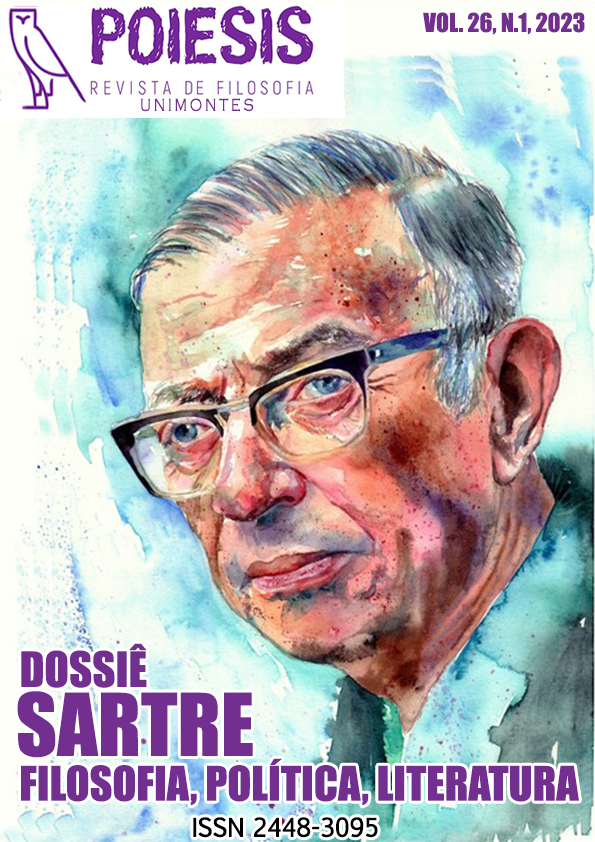THE NOTION OF BODY IN SARTRE
Keywords:
Body; consciousness; psyche; contingency; alterity.Abstract
The analytical cut of the essays of phenomenological psychology and ontology, as well as
of fictional writings published by Jean-Paul Sartre throughout the 1930s and 1940s, reveals the
elaboration of a philosophical conception of body. Among the first essays, The Transcendence of the
Ego (1936), The Imagination (1936), and The Imaginary (1940) propose relations and suggest some
definitions – in particular, the association of the body with a magical object; in Sketch for a Theory of
the Emotions (1939), in a more direct way, Sartre refers to a double corporeal character-it is an "object
in the world," but also the "immediate lived experience of consciousness" (SARTRE, 1939/2008, p.
77). A more refined theoretical proposal appears only in 1943, with the publication of Being and
Nothingness and a chapter dedicated to the body's modes of being: the for-itself, the for-other and the
"for-itself-for-other". The body is facticity; the contingent texture of consciousness or the univocal
relation to the world - "I exist my body" (SARTRE, 1943/2015, p. 441). However, it is also an object
that refers to an otherness; a relation with the world and with oneself, to which I transcend - a psychic
object. Moreover, and finally, it points to an alienated self, the result of my apprehension as an object
for the other. This ontological and dialectical approach would demarcate, at the same time, bridges and
fractures in relation to the phenomenological psychology texts, and would put in evidence the Sartrean fiction, especially the novel Nausea, as a crucial theoretical reference, given the confluence between
the notions of body and contingency.
Downloads
References
CABESTAN, P. “What is it to move oneself emotionally? Emotion and affectivity according to Jean-Paul Sartre”. Tradução de Kirk M. Besmer. Phenomenology and the Cognitive Sciences, v. 3, n. 1, p. 81-96, mar., 2004.
COHEN-SOLAL, Annie. Sartre: uma biografia. Tradução de Milton Persson. Porto Alegre: L&PM, 2008.
DILLON, M. C. “Sartre on the phenomenal body and Merleau-Ponty's critique”. Journal of the British Society for Phenomenology, v. 5, n. 2, p. 144-158, 1974.
FERRETTI, M. G. “O estatuto do corpo em “Esquisse d’une théorie des émotions”, de JeanPaul Sartre”. Trans/Form/Ação, Marília, v. 36, n. 3, p. 129-154, set./dez., 2013.
HILGERT, L.H. Natureza e liberdade: o corpo na ficção sartriana. É: Revista Ética e Filosofia Política, v. I, n. XXIII, jun., 2020.
HOWELLS, C. The Cambridge Companion to Sartre. Cambridge: Cambridge University Press, 1992.
IZUMI-SHEARER, S. Le corps ambigu chez Jean-Paul Sartre . Etudes de langue et litterature
francaises, v. 28, p. 96-115, 1976.
MERLEAU-PONTY, Maurice. Fenomenologia da percepção. Tradução de Carlos Alberto Ribeiro de Moura. 2ª ed. São Paulo: Martins Fontes, 1999.
MORRIS, K.J. (Ed.) Sartre on the Body. Londres: Palgrave Macmillan, 2010.
NOUDELMANN, N. et PHILIPPE, G. (Direction). Dictionnaire Sartre. Paris: Éd. Champion, 2004.
SARTRE, J-P. A imaginação. Tradução de Luiz Roberto Salinas Fortes: Nova Cultural, 1987.
____________. A Náusea. Tradução de Rita Braga. Rio de Janeiro: Nova Fronteira, 2011.
____________. A transcendência do ego: esboço de uma descrição fenomenológica. Tradução de João Batista Kreuch. Petrópolis: Vozes, 2013.
____________. Esboço para uma teoria das emoções. Tradução de Paulo Neves. Porto Alegre: L&PM, 2008.
____________. Esquisse D'une théorie des émotions. Paris: Hermann, 1995.
____________. La Nausée. Saint-Amand: Gallimard, 1972.
____________. L'être et le néant: essai d'ontologie phénoménologique. Paris: Gallimard, 1976.
____________. O imaginário. Tradução de Duda Machado. São Paulo: Ática, 1996.
____________. O muro. Tradução de H. Alcântara Silveira. Rio de Janeiro: Nova Fronteira, 2017.
____________. O ser e o nada: ensaio de ontologia fenomenológica. Tradução de Paulo Perdigão. 24ª ed. Petrópolis: Vozes, 2015.
____________. War Diaries: Notebooks from a Phoney War 1939-1940. Tradução de Quintin Hoare. Verso: Londres, 1999.
TIBERGHIEN, G. A. Courts-circuits. Paris: Du Felin, 2008.
Downloads
Published
How to Cite
Issue
Section
License
Copyright (c) 2023 Revista Poiesis

This work is licensed under a Creative Commons Attribution-NonCommercial-NoDerivatives 4.0 International License.





.png)

